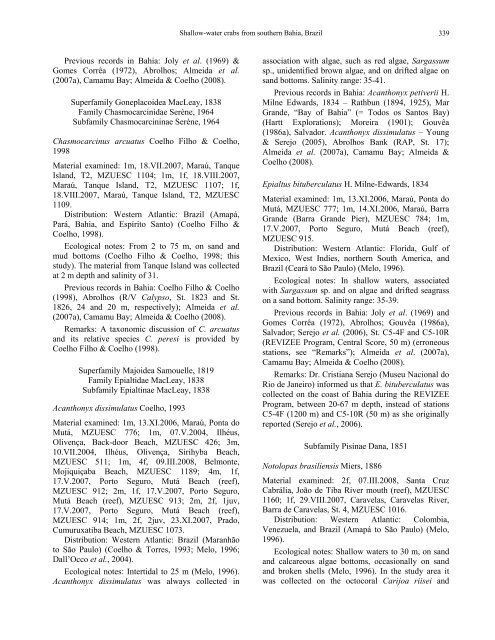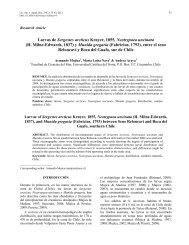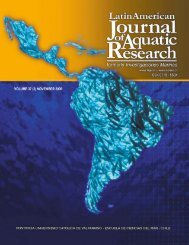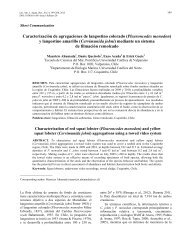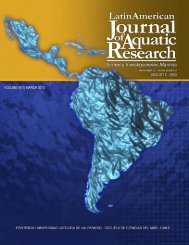Portada LAJAR.psd - Latin American Journal of Aquatic Research
Portada LAJAR.psd - Latin American Journal of Aquatic Research
Portada LAJAR.psd - Latin American Journal of Aquatic Research
You also want an ePaper? Increase the reach of your titles
YUMPU automatically turns print PDFs into web optimized ePapers that Google loves.
Previous records in Bahia: Joly et al. (1969) &<br />
Gomes Corrêa (1972), Abrolhos; Almeida et al.<br />
(2007a), Camamu Bay; Almeida & Coelho (2008).<br />
Superfamily Goneplacoidea MacLeay, 1838<br />
Family Chasmocarcinidae Serène, 1964<br />
Subfamily Chasmocarcininae Serène, 1964<br />
Chasmocarcinus arcuatus Coelho Filho & Coelho,<br />
1998<br />
Material examined: 1m, 18.VII.2007, Maraú, Tanque<br />
Island, T2, MZUESC 1104; 1m, 1f, 18.VIII.2007,<br />
Maraú, Tanque Island, T2, MZUESC 1107; 1f,<br />
18.VIII.2007, Maraú, Tanque Island, T2, MZUESC<br />
1109.<br />
Distribution: Western Atlantic: Brazil (Amapá,<br />
Pará, Bahia, and Espírito Santo) (Coelho Filho &<br />
Coelho, 1998).<br />
Ecological notes: From 2 to 75 m, on sand and<br />
mud bottoms (Coelho Filho & Coelho, 1998; this<br />
study). The material from Tanque Island was collected<br />
at 2 m depth and salinity <strong>of</strong> 31.<br />
Previous records in Bahia: Coelho Filho & Coelho<br />
(1998), Abrolhos (R/V Calypso, St. 1823 and St.<br />
1826, 24 and 20 m, respectively); Almeida et al.<br />
(2007a), Camamu Bay; Almeida & Coelho (2008).<br />
Remarks: A taxonomic discussion <strong>of</strong> C. arcuatus<br />
and its relative species C. peresi is provided by<br />
Coelho Filho & Coelho (1998).<br />
Superfamily Majoidea Samouelle, 1819<br />
Family Epialtidae MacLeay, 1838<br />
Subfamily Epialtinae MacLeay, 1838<br />
Acanthonyx dissimulatus Coelho, 1993<br />
Material examined: 1m, 13.XI.2006, Maraú, Ponta do<br />
Mutá, MZUESC 776; 1m, 07.V.2004, Ilhéus,<br />
Olivença, Back-door Beach, MZUESC 426; 3m,<br />
10.VII.2004, Ilhéus, Olivença, Sirihyba Beach,<br />
MZUESC 511; 1m, 4f, 09.III.2008, Belmonte,<br />
Mojiquiçaba Beach, MZUESC 1189; 4m, 1f,<br />
17.V.2007, Porto Seguro, Mutá Beach (reef),<br />
MZUESC 912; 2m, 1f, 17.V.2007, Porto Seguro,<br />
Mutá Beach (reef), MZUESC 913; 2m, 2f, 1juv,<br />
17.V.2007, Porto Seguro, Mutá Beach (reef),<br />
MZUESC 914; 1m, 2f, 2juv, 23.XI.2007, Prado,<br />
Cumuruxatiba Beach, MZUESC 1073.<br />
Distribution: Western Atlantic: Brazil (Maranhão<br />
to São Paulo) (Coelho & Torres, 1993; Melo, 1996;<br />
Dall’Occo et al., 2004).<br />
Ecological notes: Intertidal to 25 m (Melo, 1996).<br />
Acanthonyx dissimulatus was always collected in<br />
Shallow-water crabs from southern Bahia, Brazil<br />
339<br />
association with algae, such as red algae, Sargassum<br />
sp., unidentified brown algae, and on drifted algae on<br />
sand bottoms. Salinity range: 35-41.<br />
Previous records in Bahia: Acanthonyx petiverii H.<br />
Milne Edwards, 1834 – Rathbun (1894, 1925), Mar<br />
Grande, “Bay <strong>of</strong> Bahia” (= Todos os Santos Bay)<br />
(Hartt Explorations); Moreira (1901); Gouvêa<br />
(1986a), Salvador. Acanthonyx dissimulatus – Young<br />
& Serejo (2005), Abrolhos Bank (RAP, St. 17);<br />
Almeida et al. (2007a), Camamu Bay; Almeida &<br />
Coelho (2008).<br />
Epialtus bituberculatus H. Milne-Edwards, 1834<br />
Material examined: 1m, 13.XI.2006, Maraú, Ponta do<br />
Mutá, MZUESC 777; 1m, 14.XI.2006, Maraú, Barra<br />
Grande (Barra Grande Pier), MZUESC 784; 1m,<br />
17.V.2007, Porto Seguro, Mutá Beach (reef),<br />
MZUESC 915.<br />
Distribution: Western Atlantic: Florida, Gulf <strong>of</strong><br />
Mexico, West Indies, northern South America, and<br />
Brazil (Ceará to São Paulo) (Melo, 1996).<br />
Ecological notes: In shallow waters, associated<br />
with Sargassum sp. and on algae and drifted seagrass<br />
on a sand bottom. Salinity range: 35-39.<br />
Previous records in Bahia: Joly et al. (1969) and<br />
Gomes Corrêa (1972), Abrolhos; Gouvêa (1986a),<br />
Salvador; Serejo et al. (2006), St. C5-4F and C5-10R<br />
(REVIZEE Program, Central Score, 50 m) (erroneous<br />
stations, see “Remarks”); Almeida et al. (2007a),<br />
Camamu Bay; Almeida & Coelho (2008).<br />
Remarks: Dr. Cristiana Serejo (Museu Nacional do<br />
Rio de Janeiro) informed us that E. bituberculatus was<br />
collected on the coast <strong>of</strong> Bahia during the REVIZEE<br />
Program, between 20-67 m depth, instead <strong>of</strong> stations<br />
C5-4F (1200 m) and C5-10R (50 m) as she originally<br />
reported (Serejo et al., 2006).<br />
Subfamily Pisinae Dana, 1851<br />
Notolopas brasiliensis Miers, 1886<br />
Material examined: 2f, 07.III.2008, Santa Cruz<br />
Cabrália, João de Tiba River mouth (reef), MZUESC<br />
1160; 1f, 29.VIII.2007, Caravelas, Caravelas River,<br />
Barra de Caravelas, St. 4, MZUESC 1016.<br />
Distribution: Western Atlantic: Colombia,<br />
Venezuela, and Brazil (Amapá to São Paulo) (Melo,<br />
1996).<br />
Ecological notes: Shallow waters to 30 m, on sand<br />
and calcareous algae bottoms, occasionally on sand<br />
and broken shells (Melo, 1996). In the study area it<br />
was collected on the octocoral Carijoa riisei and


